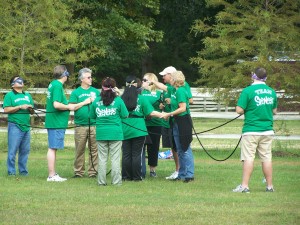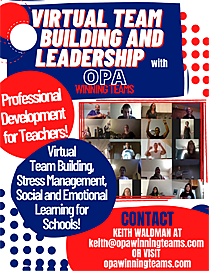There is much more to becoming a championship caliber team than the skill level of each player. The  amount of communication, working together, and mutual respect is crucial in becoming a high performing team. A vital component of winning the mental and team game of sport is the cohesiveness of your team. While winning a championship ring is awesome, the most vivid memories and feelings that stay with a team are the special relationships that are developed throughout the season. The challenges they faced together, the successes they shared, and the tears they shed. When it’s all said and done your players will look back not just on the number of wins or titles but the relationships they formed with teammates and coaches. I have found from my professional experience as a team building/peak performance coach and from my personal experience with athletics, the more cohesive a team is, the more your players will reach peak performances. Team cohesion will help your team rise to greater levels because they will be playing not just for themselves but for each other. I have found that teams, who have a high level of trust and support within the group, will feel safe enough to take risks on the field and as a result they will play to win rather than worrying about making mistakes on the field. These teams realize that winning takes more than just performance. It takes the full contribution of each team member. The teams that I worked with who performed on a high level realized that they can’t do it alone and that everybody must contribute their own special talent. When teams believe in themselves and in each other that’s when wonderful things tend to happen.
amount of communication, working together, and mutual respect is crucial in becoming a high performing team. A vital component of winning the mental and team game of sport is the cohesiveness of your team. While winning a championship ring is awesome, the most vivid memories and feelings that stay with a team are the special relationships that are developed throughout the season. The challenges they faced together, the successes they shared, and the tears they shed. When it’s all said and done your players will look back not just on the number of wins or titles but the relationships they formed with teammates and coaches. I have found from my professional experience as a team building/peak performance coach and from my personal experience with athletics, the more cohesive a team is, the more your players will reach peak performances. Team cohesion will help your team rise to greater levels because they will be playing not just for themselves but for each other. I have found that teams, who have a high level of trust and support within the group, will feel safe enough to take risks on the field and as a result they will play to win rather than worrying about making mistakes on the field. These teams realize that winning takes more than just performance. It takes the full contribution of each team member. The teams that I worked with who performed on a high level realized that they can’t do it alone and that everybody must contribute their own special talent. When teams believe in themselves and in each other that’s when wonderful things tend to happen.
??Why Teambuilding??
Teams: Why they succeed
Team experiences can be exhilarating. There is a bond formed when working with others and being mutually involved with searching for possible solutions rather than feeling alone and overwhelmed. There is the caring and closeness that develops among team members that know each other, as they never did before. There is the insight of listening to someone and suddenly understanding yourself. There is the wonder of watching people decide to change. There is the joy of experiencing the click when finding the right solution. There is the shared pleasure of achieving a common goal. Once there are successful encounters like this, the positive team behavior will continue.
Teams: Why they don’t succeed
Working in groups can make some people feel uncomfortable. In a group, you don’t get your own way. You must defer to others at least some of the time. Discussions can be confusing, individual differences can explode to produce heightened conflict. Additionally, fear may be intensified by group dynamics – fear of appearing foolish or regarded as low status, fears of being scapegoated or being dumped on, fears of not fitting in or being an outcast, and fears about outcomes. There is also some sense of loss of control. Lastly, most of us have difficulty working with teams because we don’t know how to work well with others and this inexperience promotes avoidance.
Team Building 1.0
Show me and I can see; tell me and I can hear; but it is only through experience that I can truly understand. When I conduct my team building sessions I use a combination of adventure programming and sport psychology. As you know athletes are very physical people who love challenges, games, and activities. I have found the concept of learning by doing to be an effective means of working with athletes. Your team will love many of the team building activities but more importantly the goal of activities is for your team to gain insights and strategies that will help win the mental and team game of your field hockey. To me, the key to mental toughness is awareness. Field hockey is an awareness sport and the more aware your players are of themselves, each other, and about their sport – the more effective they will be on the field.
If you decide to conduct some of your team building activities it’s best to plan your activities in a progressive manner with each challenge building on the next and organized around key themes for your team. For example, if you want to foster better communication among group members, then your activities should include initiatives that call for various combinations of players taking a leadership role in giving directions, commands or ideas in both verbal and non-verbal means of communication. If you want to develop team trust, then initiatives should include activities that ask teammates to relinquish control and power to another teammate in a safe, non-threatening manner. You may want to choose themes based on my 12 Building Blocks of High Performing Teams.
Laying the “Ground Rules”
Establishing ground rules for the activities should be given to your team including the goals for the activity, any team rules you want to encourage (for example, “only positive verbal comments are to be shared,” “let’s all respect individual differences,” or “let’s foster a safe environment both physically and emotionally” or “playing to win rather than playing to loose”). Let players know that there is a purpose to these activities and while they may be having a great time laughing, having fun and enjoying themselves, there is a deeper meaning and deeper meaning of the activities will be explored. Let them know that these messages will be addressed at the end of the session.
“Taking It Back” – It’s not over until the “Debriefing”
One error that many team leaders often commit is to focus almost exclusively on the initiatives themselves and neglect the debriefing session at the end of training. Without proper “wrap up” these activities will serve little more purpose than as an opportunity to have a good time. At the final debriefing, lessons extracted from the day’s activities should be explored. Players’ opinions should be drawn out and they should be asked to explain what they saw, heard, learned and felt during the team building actives and what potential applications could be derived for the team or for the season. In many ways, the debriefing sessions are as important, if not more so, than the activities themselves. Debriefing translates the fun and challenge of an experience into an opportunity for growth and self-awareness. Without processing, the activity is simply an experience with limited outcomes and value.
Your challenge is to effectively facilitate the debriefing session. To be an effective facilitator, your job is to get your team to see how the success or lack of success relates back to the team. To do this you need to create an atmosphere of trust where each team member will be able to freely discuss their experiences and feelings. To create this trusting atmosphere you should try not to judge your team for their honest feedback or holding anything against that person after the activity. Some athletes may not speak the truth because they worry about negative consequences from the coach. For the team building activities to be successful each team member must commit to speak the truth.
Team Building Drill
Blind Polygon: This is a challenging problem-solving activity that casts light on the
communication & listening skills, team roles, trust, and problem solving processes.
Equipment: One blindfold per participant; one 50 – 100 foot length of rope
Group Size: Groups of 15
How to Play
Blindfold the group, lay a rope on the ground somewhere in their midst, then cryptically tell them that
there is something in their midst that they will need to find, that they will know it when they find it, and that you will give the group further instructions when each person is holding the prop. Instruct them to move slowly and with their hands out in front of them to prevent bumps. After the group finds the rope, tell them to make it into as perfect a square as they can, and that they will have up to twenty minutes to do so. When the group decides that it has made a square, they can remove their blindfolds and check their work. Know you can ask the group to make a polygon as well as other shapes.
Variation:
Divide the team into 3 groups and have perform the task with the following limitations:
- 1 group of people can see, but can’t talk or move.
- 1 group of people can move and talk (softly), but can’t see (blindfolded)
- 1 group of people can move and talk (loudly, but can’t see (blindfolded)
Debrief:
Did they plan what they were going to do or just jump at the first suggestion? Was everyone involved in the planning or did one person dominate? Were their efforts coordinated or was everyone proceeding independently? How did they organize themselves? How were individual responsibilities assigned? Did they choose a leader? If not, did a leader emerge from their activity, or was there no leadership? What leadership methods were used and how effective were they? How could they improve their planning and cooperation for more efficient teamwork?
Keith Waldman Bio: For over a decade Mr. Keith Waldman has been a partner with Optimal Performance Associates, LLC. Keith has been a popular speaker for many collegiate and high school athletic programs and conferences. He has conducted hundreds of workshops for Division I-III sport teams and athletic departments across the nation, including State, Conference, and National Championship Teams. In addition to his work with athletics, Keith has facilitated hundreds of exciting workshops for many K-12 schools and corporations, including many Fortune 500 companies focusing on interpersonal practice, teambuilding, and performance. To get more information about his team building programs or to order the Beyond the X’s & O’s Team Chemistry Playbook you can visit the OPA website at www.opawinningteams.com or call Keith Waldman at (888) 868-3380 or you can contact him by email at Keith@opawinningteams.com.



